I’ve written about numerous Whitney Tilson stock teaser presentations on this blog, and overall, I’d have to say that I have found his research interesting.
So I finally decided to give his Empire Stock Investor service a go.
And in this review, I’ll show you everything I found.
I’ll start by discussing what the service is about and how it works, and then I’ll show you how the stock picks have performed, who Tilson is, the pros and cons, and more.
What Is Empire Stock Investor?
Empire Stock Investor is Whitney Tilson’s flagship investment newsletter that, according to the Empire Financial Research website, helps readers “safely grow their wealth.”
Basically, the way it works is Tilson shares his knowledge and recommendations with subscribers who can choose to follow what he says in the hopes of seeing a profit.
Depending on how you join, the service costs $49 for the first 12 months, and that gives you access to monthly newsletters from Whitney Tilson, a model portfolio of stock picks, and in-depth research on the different companies he and his team recommend.
I’ll elaborate further on what you get as a subscriber, but that’s the gist of it.
What type of stocks does Tilson recommend?
To some extent, Whitney Tilson’s investment philosophy models that of Warren Buffet, who’s arguably the greatest value investor of all time.
However, Tilson has described himself on numerous occasions as a “make-money investor” as opposed to a traditional value investor.
What does that even mean?
It’s probably best to let Tilson himself answer that one.
Here’s how Whitney Tilson described his “make-money investor” approach in a recent Empire Stock Investor newsletter, which was in the context of discussing some of his recent tech and biotech stock picks (emphasis mine):
“These purchases were a clear departure from traditional value investing, which is what we practiced at the beginning of our careers…
“But as we mentioned at the outset of this newsletter, we now consider ourselves make-money investors.
“That means we take the best of both value and growth approaches to build a diversified portfolio that can make money in any kind of market environment.”
– Whitney Tilson (snippet from November 2022 newsletter issue)
And according to the Empire Financial Research FAQ page (inside the member’s area), Tilson is “on the hunt for beaten-down stocks trading at half of their intrinsic value.”
So, his approach is essentially a combination of value and growth, and he looks for stocks that are potentially deeply undervalued.
I’m a fan of the latter part of his approach (in general) because it can help you find stocks with potentially limited downside risk and high upside potential (i.e., asymmetry).
Of course, just because a stock is “beaten down” doesn’t mean it’s a good idea. But when you combine that with a company that you believe has strong long-term fundamentals, among other things, that’s when things can get exciting.
In any case, the reality is that Tilson DID recommend a bunch of tech and biotech stocks last year that were anything but “beaten down.”
In fact, some were trading at or near all-time highs, and given the crash we’ve seen in many of those companies this year, safe to say that this didn’t work out too well.
So not everything he’s recommended has been a winner.
Nevertheless, that’s the gist of what the Empire Stock Investor service is about and the strategy Tilson uses to find the stocks he recommends.
In the next section, I’ll show you what happens after you join, what the newsletters are like, and how Tilson’s stock picks have performed since the service began in 2019.
How Does Empire Stock Investor Work?
The basic idea behind Empire Stock Investor is that, as a subscriber, you get monthly insights and stock ideas from Whitney Tilson, which are aimed at helping readers grow their wealth.
And once you sign up, there are basically three main things you get access to:
- Monthly newsletter issues
- Model portfolio
- Special reports
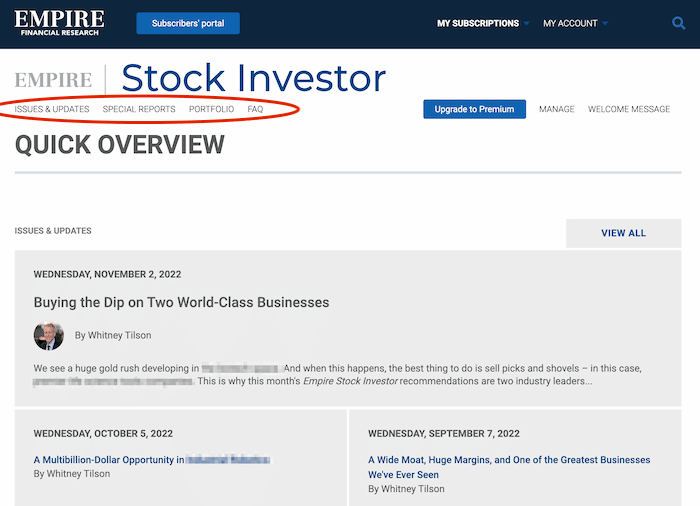
You also get access to an FAQ page and a page where you can manage your account (among other things), but those are the main aspects of the service.
So with that said, let’s discuss each of these now…
Monthly Newsletters
The monthly newsletters are where Whitney Tilson shares his latest investment ideas and provides updates on the recommendations he’s already made.
Each issue is released on the first Wednesday of every month, is available in either blog post form or as a PDF download, and is around 10 pages long.
Here’s a preview to show you what it looks like:
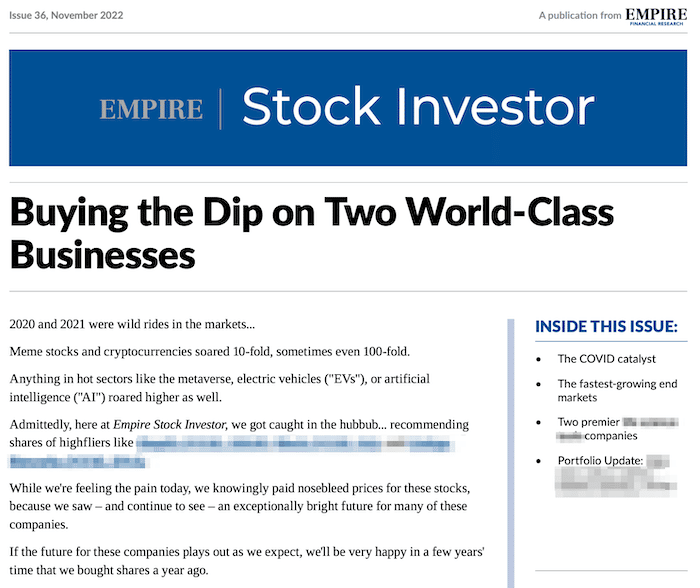
Each issue is different, but the general gist of how Tilson writes them is similar.
He basically gives you a broad look into an industry or technology he’s been researching and then moves on to discuss one or more companies he believes can dominate the space.
Sometimes, he starts out with a discussion about the U.S. economy and broader financial market trends, but he seems to focus mostly on companies and their respective industries.
Tilson also provides a lot of insight into the fundamentals of the companies he recommends, as you’d expect from someone with a value-investing background.
For example, he talks about the company’s business model, revenues, earnings before interest, taxes, depreciation, and amortization (EBITDA), growth prospects, and more.
Furthermore, there’s an “action to take” section that shows you the company’s ticker and the “buy up to” price he’s recommending. And Tilson shares numerous charts and illustrations throughout the newsletters to add more context and value to the research.
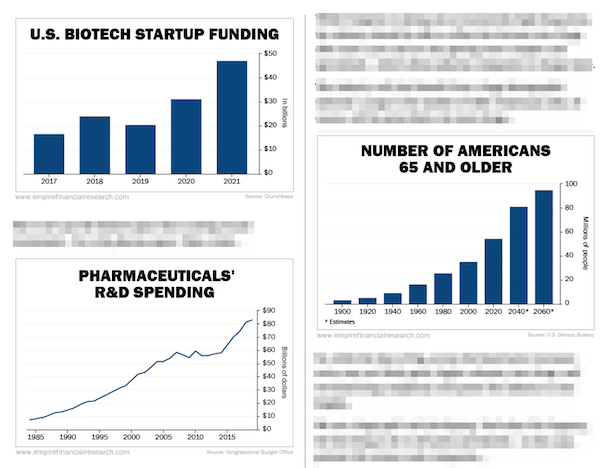
And lastly, there’s a “portfolio update” section, where Tilson walks you through any changes related to companies he’s previously recommended, such as updates on how they are performing and whether or not he suggests selling.
It’s not the longest newsletter I’ve come across, but ten pages is about the norm, and the information Tilson includes is very informative. So it’s a decent newsletter.
Model Portfolio (stock picks)
The model portfolio is where you can see all of the Empire Stock Investor recommendations in one place. It’s basically a list of every company Tilson has recommended.
And one thing Tilson does (that many other newsletters don’t) is that he provides a model portfolio of both the open AND closed positions.

This may not seem like a big deal, but it is.
Why? Because the open portfolio shows you the active recommendations, while the close portfolio shows you the whole history of everything he’s recommended, which allows you to see firsthand how well the service has performed since its inception.
In other words, Tilson’s service is more transparent than most.
To be clear, this isn’t me trying to shill Empire Stock Investor. I’m not affiliated with Tilson, so it makes no difference to me if you join or not. But this does add a layer of credibility to the service, and it’s not what most services do, so I thought it was worth mentioning.
In any case, how have the stock picks performed?
Well, here are the CLOSED positions as of writing:
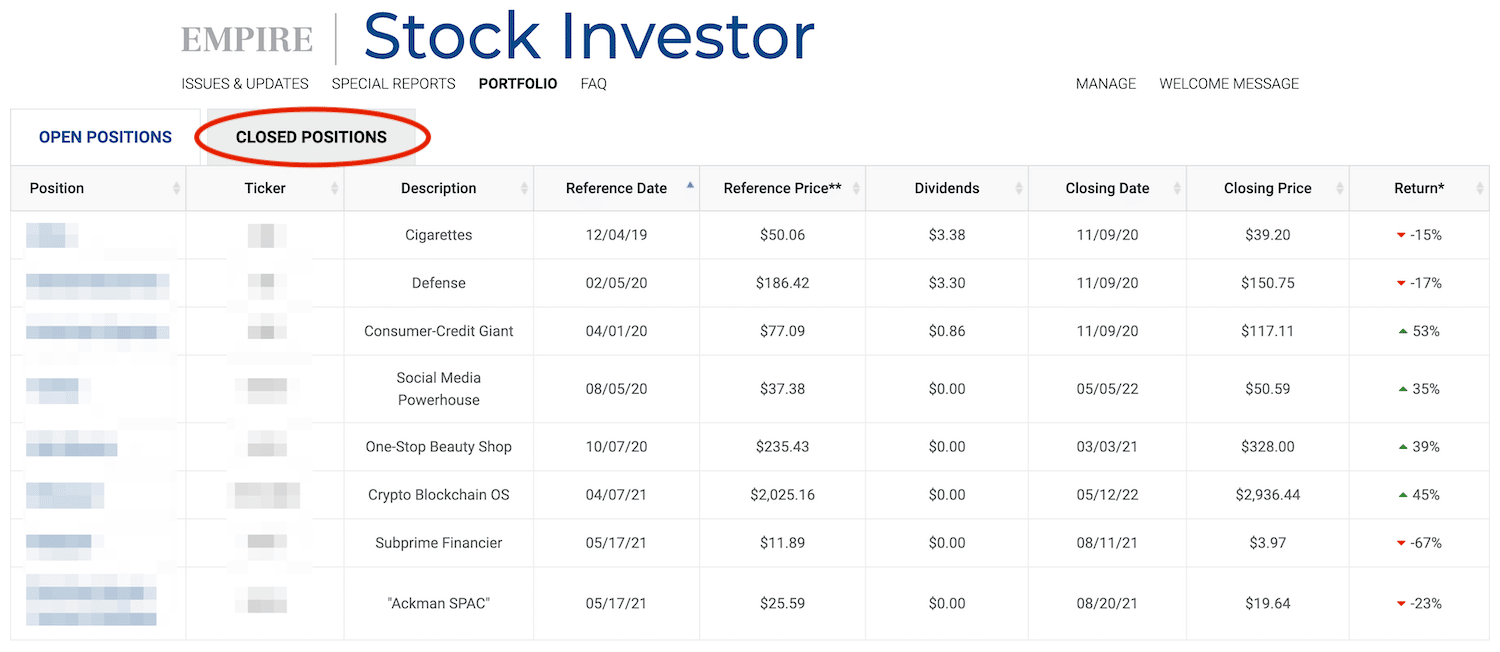
As you can see, it’s a bit of a mixed bag.
Half of the picks have worked out; half haven’t.
Tilson’s biggest winner (with this service) has been 53% in a bit over seven months, and the biggest loss was 67% in a little under three months. But overall, his closed recommendations are up more (percent-wise) than they are down.
Update on the Closed Positions (April 2023)
The following is an update on how the recommendations in the “closed positions” tab have performed since I wrote this review in late 2022:
As you can see, there has been one winning pick (81%) and one losing pick (-72%) added.
What About the OPEN Stock Picks?
There are currently over 40 stocks in the open model portfolio, which is one of the highest numbers of stocks I’ve seen in any service to date.
And they are grouped into two separate portfolios.
One is called “stocks,” and the other is called “TaaS,” which relates to Whitney Tilson’s Transportation as a Service teaser that he released a while back.
As of writing, the performance of the open portfolios (“stocks” and “TaaS” combined) is (roughly) an even split between the number of winning and losing picks.
His top three picks are between high double-digit to low triple-digit percentage gains, and his worst three picks are between mid-to-high double-digit percentage losses.
But again, these are open recommendations, so how well these picks have performed can change each day the market is open until Tilson recommends selling.
And for whatever reason, the portfolio doesn’t appear to have been updated for a while. I’m literally just going off what’s shown in the member’s area portfolio, but the actual performance of the open picks as I write this could be somewhat different.
In any case, I think it’s safe to say that Tilson’s Empire Stock Investor picks haven’t worked out as well as I’d hoped. Although, to be fair, most of the market has sold off this year, and this isn’t a trading service, it’s a newsletter for long-term investors.
So it’ll be interesting to see how things work out going forward.
And to keep you in the loop, I will update this post at least once or twice over the coming 12 months. So, for example, I will strive to update this section by mid-2023. And if I forget, feel free to remind me in the comments section below!
Special Reports
The last section of the Empire Stock Investor subscription I want to highlight is the “special reports” section, which is where you can access different research reports Whitney Tilson has released that discuss the companies he’s interested in.
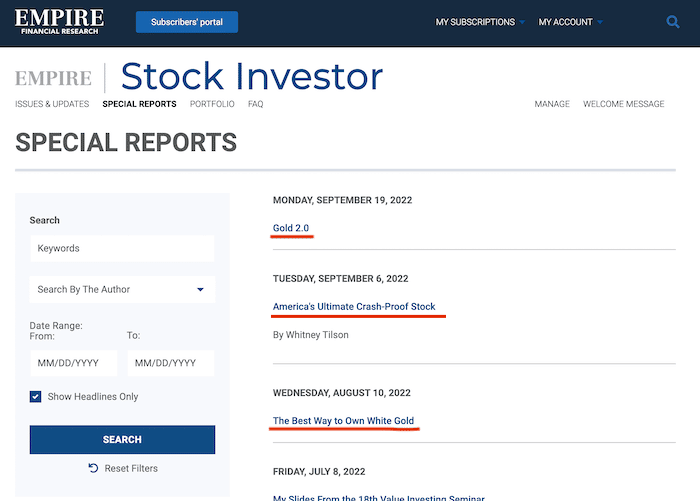
These reports are often used to incentivize people to join Empire Stock Investor, so chances are you may have heard about one or more of them yourself.
Basically, Tilson releases different presentations teasing companies he likes, and the only way to find out what they are is to join the service. And as a subscriber, you get access to these reports and any new ones he releases over the next 12 months.
These reports are worth reading, too, especially if you’re considering following Tilson’s recommendations – because they explain why he’s bullish.
They are similar to the newsletters in that respect, except they focus exclusively on one or more companies he’s interested in and are released more randomly.
Also worth mentioning is that there are links included in the model portfolio that take you to the research report or newsletter where Tilson breaks down his investment thesis and recommendation. So these resources (newsletter, reports, portfolio) work together to show you what companies he’s interested, why he likes them, and what he’s recommending.
Recommended: Go here to see my #1 rated stock advisory of 2024
Who Is Whitney Tilson?
Whitney Tilson is the CEO and founder of Empire Financial Research, the New York-based company behind the Empire Stock Investor service.
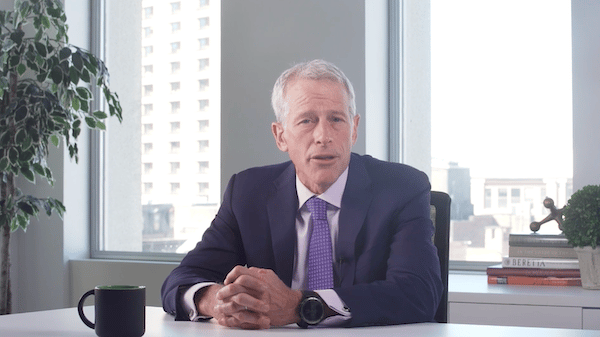
Prior to founding this company, the Empire Financial Research website states that Tilson earned an MBA from Harvard Business School in 1994 and founded a money management firm called Kase Capital Management (in 1999), which he grew to over $200 million in assets under management after starting the company out of his bedroom.
According to a 2016 CNBC article, however, the “public is most familiar with Tilson” from his appearances in two different 60 Minutes segments. One was about the housing crisis in 2008, and another was about Lumber Liquidators in 2015.
Here’s the 60 Minutes clip about the housing crisis from 2008:
Now here’s the clip about Lumber Liquidators from 2015 (I skipped to where Tilson talks):
According to his Empire Financial Research bio, Tilson has made appearances on a variety of popular news shows, written for well-known finance sites, and published four books, his latest one being “The Art of Playing Defense: How to Get Ahead by Not Falling Behind.”
How have his stock picks worked out?
We’ve already discussed how his Empire Stock Investor picks have performed so far (“meh”), but some of his most notable investments, according to the company site, include Netflix, Amazon, and Apple, which the site says each saw very significant gains.
It’s unclear if those were recommended to his followers or just his personal investments. But still, assuming that’s true, he has picked some pretty epic stocks, and he has also made accurate predictions about the economy and markets.
None of this means you’ll get rich following Tilson’s picks. But based on everything I’ve seen, he is a real investment expert who has developed a strong track record overall.
And I’ve created an article about Tilson’s latest stock picks and predictions, which you may find helpful if you want to know more about what he’s recommended.
For obvious reasons, I can’t reveal the stocks he’s recommending inside the Empire Stock Investor service. But I have written about many of his recent stock teaser presentations and, using the clues he’s shared publicly, uncovered a bunch of his picks.
So check the above post out if you want to know about his more recent picks.
Is Empire Financial Research Legit?
Empire Financial Research is a New York-based financial publishing company that sells a variety of subscriptions, and it’s owned by a public company called MarketWise.
The company’s flagship service is Empire Stock Investor, but Empire Financial Research sells numerous other services, many of which are higher priced.
Whitney Tilson, the guy who founded the company, writes the Empire Stock Investor newsletter and one called Empire Investment Report, which costs $3,000 per year.
And aside from Tilson, Enrique Abeyta, Herb Greenberg, and several others contribute to the newsletters that Empire Financial Research publishes.
So, is it legit?
Yes, Empire Financial Research is legit.
The company provides quality research at a fair price, and while not everything they recommend works out, it’s not a scam.
However, I’m not a fan of some of their services (like their “crypto” one, for example).
And there are some complaints about the company online, which mostly seem to center around the marketing side of things, which I can totally understand.
Here’s why I say that:
- For one thing, the company puts out lots of different presentations, and some of these can be a bit overhyped and lead people to join, thinking it could be a way to get rich in a short time.
- There are also lots of upsells in store for those who join, and getting subscribers to buy into those is a big part of the company’s overall business model.
- After researching/joining hundreds of these types of services, I can safely say that my email account will never be the same… lol. You should probably expect to receive some annoying promo emails if you join this, which is why I normally suggest using a separate email account that you don’t really care about or use much.
- And lastly, one thing that might catch some people off guard is that the service automatically renews at $199 after 12 months. And this isn’t exactly obvious unless you read the “fine print” under the order form when you go to join.
So if you’ve joined for $49, expect to be billed $199 in a year unless you turn off the auto-renew feature, which, thankfully, is pretty easy to do. All you need to do is click on the “manage account” tab in the member’s area and navigate to where you can turn it off.
In any case, aside from the marketing, which is something I detest about most investment newsletter companies, Empire Financial Research is a legit company.
And to be fair, I haven’t found Tilson’s pitches to be as overhyped as most.
He’s also transparent enough to share the “closed” portfolio positions with subscribers, which, believe it or not, is quite rare in the newsletter space.
I will probably always be skeptical of companies like this, given their aggressive marketing practices, but I don’t think that this alone is enough to call something a scam.
Pros and Cons of Empire Stock Investor
As with any service, there are a variety of pros and cons to consider before signing up, and in this section, I’ll do my best to list what I think the main ones are.
Pros
- Whitney Tilson is a genuine expert. Tilson is a very knowledgeable investor, which is evident by looking into his career and reading his newsletters. And while I don’t know him personally, he seems to be one of the more ethical and transparent “gurus” in the stock-picking space. Maybe I’m drinking the Kool-Aid here, but it seems that way to me.
- The stock picks aren’t tied to any one sector. Tilson’s picks are diversified across numerous sectors (energy, tech, utilities, biotech, construction, etc.). His main picks center around tech and biotech, but his picks are spread across multiple sectors.
- You can verify Tilson’s closed recommendations. As mentioned, I’m a fan of how Tilson is transparent enough to share the Empire Stock Investor’s entire track record inside the member’s area. That, to me, shows a higher level of integrity than many.
- The newsletters are informative. If you’re looking for a global macro newsletter, this isn’t it, but Tilson shares a lot of detailed information about the companies he recommends, as well as the industries the companies are in.
- You can join for $49. For less than $50, you get a whole year’s worth of newsletters, stock picks, research reports, and updates from Tilson, which I think is good value.
Cons
- Most of the open stock picks are down. The “closed” portfolio has done okay, and the “open” portfolio is a (roughly) 50/50 split between winners and losers, but overall there are a lot of losing recommendations as of writing.
- The marketing is aggressive. From the various “presentations” and upsells to the less-than-obvious $199 auto-renew policy and promo emails you get… the marketing side of things isn’t cool. That said, Empire Financial Research is not the worst in this respect.
- The refund policy is unclear. I’m pretty sure that Empire Stock Investor comes with a 30-day refund, but the “terms” page on the company site seems to suggest that most of their higher-priced services are non-refundable. So this may be something worth checking with their support team before joining (empirefinancialresearch.com/contact).
Bottom Line
If you’re looking for a newsletter service that embraces Tilson’s “make money investor” approach, which is essentially a cross between growth and value investing, then Empire Stock Investor may be worth a look.
As mentioned, the stock picks haven’t worked out as well as I’d hoped in 2022, but this is a newsletter for long-term investors, not traders, so there’s still plenty of time for the portfolio to come out strong in the years ahead.
And at the very least, you will probably learn a thing or two from Tilson about valuing different companies, as he is a very knowledgeable investor with over two decades of experience and shares that knowledge with subscribers.
Anyway, that’s my take.
I hope what I’ve shared in this review helps you make a more informed choice one way or the other. And whatever you decide, keep in mind that investing is risky and that there’s never a guarantee you’ll make money following someone’s stock ideas.

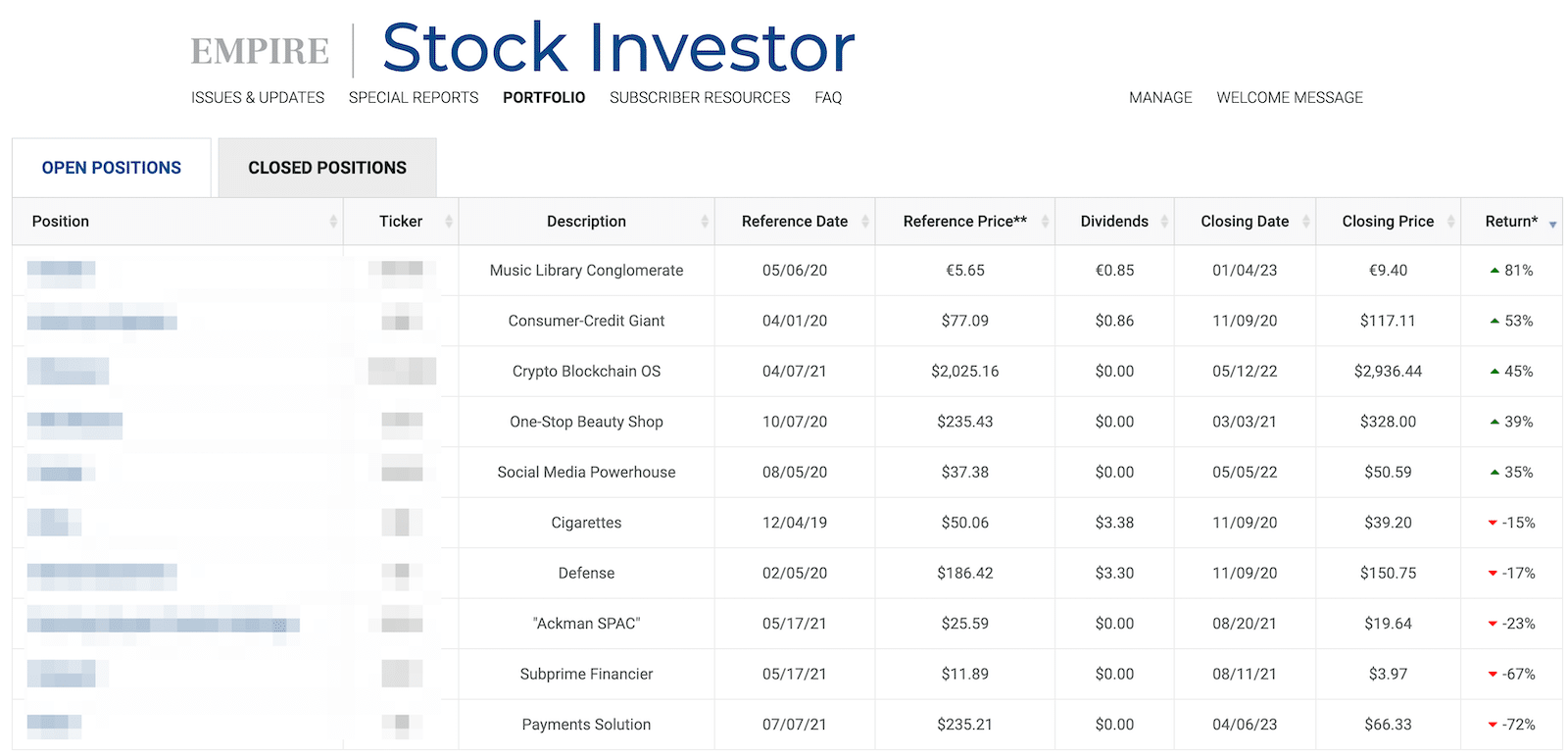








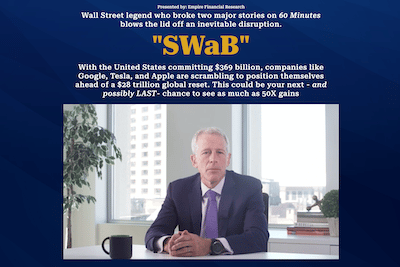


Please note: By submitting a comment using the above comment form, you confirm that you agree with the storage and handling of your data by this site as detailed in our Privacy Policy.